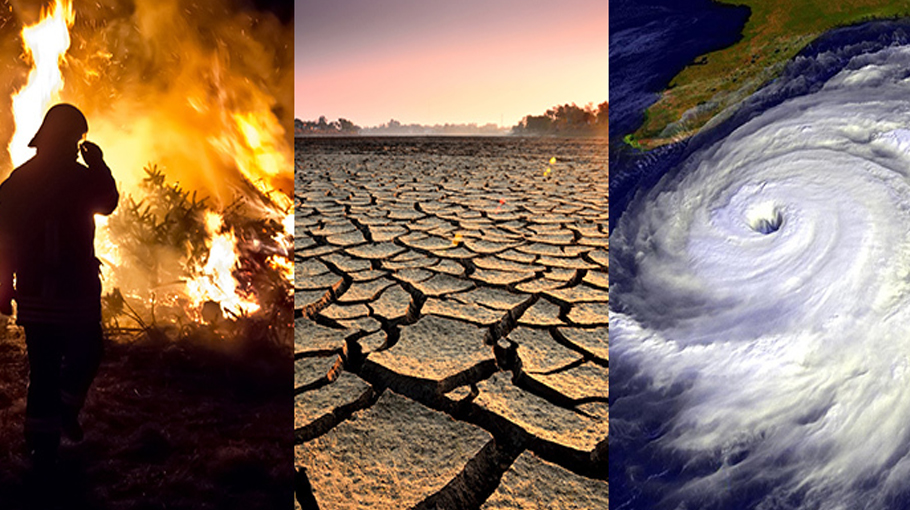Global engagement required for overcoming impact of climate catastrophe

Humanitarian agencies have warned Pakistan is in need of long-term aid as the death toll from its catastrophic flooding continues to climb. The two worst-affected provinces are Balochistan and Sindh, in southern Pakistan, where infrastructure and water systems have been damaged. The flooding has affected areas that do not usually see this type of rain- as southern regions are normally arid or semi-arid. Baluchistan, has apparently received 436% more rain than the 30-year average this monsoon according to Reuters.
The cumulative number of deaths since June 14 has crossed 1,300. That country's National Disaster Management Authority has also reported that almost a third of the victims are children.
The flooding -- the result of a combination of record monsoon rains and melting glaciers in Pakistan's northern mountains -- has been described as the worst the country has ever seen. At one point more than a third of the country was underwater, according to satellite images from the European Space Agency. The government and aid organizations have also pointed out that more than 33 million people have been affected.
Among them, more than three million children are in need of urgent humanitarian assistance due to the risk of waterborne diseases, drowning and malnutrition, according to UNICEF. It has also noted that the floods have damaged or destroyed 17,566 schools nationwide- further jeopardizing children's education after two years of Covid-related closures. It has been estimated that more than 1 million homes have been damaged or destroyed, while at least 5,000 kilometers of roads have been badly affected. More than 700,000 livestock have also been killed, most of them in the province of Baluchistan, while destruction to over 3,600 km of roads and 145 bridges has impeded access across flood-affected areas.
The southern region of the Province of Punjab has also been affected. In the historical town of Mangadotha, west of Taunsa Sharif, hundreds of houses and livestock were swept away by flood waters and about 1,780,000 acres of farmland have also been lost. The media has reported that residents of communities adjacent to flooded rivers have tried to save themselves through evacuation, with most families moving to safer places on foot with camels carrying only essential supplies.
These disclosures have led Aid agencies to suggest that even if the flooding recedes the country faces a long road to recovery as survivors in the affected areas will have to start from scratch according to Medecins du Monde.
Calling for aid from the international community, Pakistan's Prime Minister Shehbaz Sharif has estimated recently that the calamity had caused at least US Dollar 10 billion in damage to infrastructure, homes and farms. Pakistan Planning Minister Ahsan Iqbal has told Reuters that almost half of the country's cotton crop has been washed away and vegetable, fruit, and rice fields have also sustained significant damage.
In this context a National Flood Response and Coordination Center has been set up and the World Health Organization has already released US Dollar 10 million to treat the injured, deliver supplies to health facilities, and prevent the spread of infectious diseases.
Climatologist Georgina Rannard of the BBC has remarked that the devastating floods in Pakistan are a "wake-up call" to the world on the threats of climate change.
The human impacts and the subsequent food shortages created by floodwaters are being seen as a sense of injustice by many in Pakistan. Environmentalists have however remarked that though Pakistan contributes less than 1% of the global greenhouse gases that warm our planet -its geography makes it extremely vulnerable to climate change. The majority of Pakistan's population lives along the Indus River, which swells and can flood during monsoon rains.
Pakistan also has something else making it susceptible to climate change effects - its immense glaciers. Its northern region is sometimes referred to as the 'third Pole'. It contains more glacial ice than anywhere in the world outside of the Polar Regions. As the world warms, glacial ice is melting. UNDP has told BBC News that glaciers in Pakistan's Gilgit-Baltistan and Khyber Pakhtunkhwa regions are melting rapidly, creating more than 3,000 lakes- 33 of these are at risk of sudden bursting, which could unleash millions of cubic meters of water and debris, putting 7 more million people at risk.
In this context one also needs to recall the flooding that took place in 2021 in Germany and Belgium and also this year in Bangladesh. There are several least common denominators within these different paradigms. It needs to be noted here that higher than average monsoon rains were also recorded in India and Bangladesh. The Indian Ocean has become one of the fastest warming oceans in the world, warming by an average of 1 °C (1.8 °F). The rise in sea surface temperatures is believed to have increased monsoon rainfall. It is also believed that such an evolving scenario induced heatwaves that also triggered glacial flooding in Gilgit Baltistan.
Pakistan Prime Minister Shehbaz Sharif and the relevant authorities associated with disaster management have started a linked up relief operation in the wake of this massive ecological catastrophe. He held a meeting with international partners on 25 August and sought their commitment to provide adequate funds to mitigate the havoc wreaked by flooding. Interestingly, on a voluntary basis armed forces Officers, Federal Cabinet Members and Senators have decided to donate their one-month salary for flood relief fund. Pakistan's largest telecom and internet services provider- the PTCL Group- has also announced a donation of Pakistan Rupees 1.75 billion to support floods relief affectees. The Chairman of the Pakistan Tehreek-e-Insaf (PTI) party and former Pakistan Prime Minister Imran Khan has also raised through a telethon the equivalent of US Dollar 22.5 million funds for flood affectees. The Pakistan Telecommunication Authority (PTA) has also introduced a special SMS code for flood relief donations to enable the consumers to donate their funds through mobile phone text to support the flood victims. The consumers would be required to write 'fund' and send it to this code as their donation to the Prime Minister's floods relief fund.
Such proactive measures and humanitarian engagement have drawn the attention of many countries and financial institutions all over the world who have also stepped forward to assist Pakistan in its efforts towards recovery.
It needs to be mentioned here that on 30 August 2022, Bangladesh Prime Minister despite many difficulties within the country, arising out of the recent floods in the north-eastern and northern regions, announced that Bangladesh will provide aid to the flood victims in the Baluchistan province of Pakistan. Bangladesh's Ministry of Disaster Management and Relief has allocated in this context Taka 14 million to provide relief items to Pakistan including 10 tonnes of biscuit, 10 tonnes of dry cake, 100,000 water purification tablets, 50,000 packets of oral saline, 5,000 mosquito nets, 2,000 blankets and 2,000 tents.
Many international institutions have also correctly taken on the path of constructive engagement. The United Nations has allocated US Dollar 3 million from its Central Emergency Response Fund (CERF) to help the affected areas. The UN is apparently seeking additional US Dollar 160 million in emergency aid for floods relief efforts in Pakistan. Similarly, the World Health Organization is allocating US Dollar 10 million to assist relief efforts. The World Bank has also allocated US Dollar 370 million as relief aid.
The United States has also announced disaster aid of US Dollar 31 million to Pakistan to overcome the evolving challenges that have emerged after the flood disaster in Pakistan. China has also apparently signaled that it is going to provide emergency humanitarian aid of nearly US Dollar 75 million under the framework of the China- Pakistan Economic Corridor (CPEC) and also assist with the participation of the Red Cross Society of China. The United Kingdom has also come forward with a promise of financial assistance of over Pound Sterling 16 million. South Korea has announced US Dollar 300,000 in relief aid to Pakistan. Canada has also announced US Dollar 5 million funding for humanitarian assistance to Pakistan. France, interestingly, has announced that they will not only donate 83 high-capacity water pumps, 200 family tents and survival, hygiene and protective equipment to Pakistan but will also deploy doctors and nurses to the country and will ship a 50-meter-long Bailey Bridge that could be swiftly deployed in the affected areas.
The UAE, Qatar, Germany, Australia and other countries and institutions have also come forward to assist a country suffering from effects of climate variability.
Such a constructive approach needs to be followed all over the world- in Africa, Latin America and all the other regions of Europe and Asia who have faced similar effects of climate change. This will require partnership in factors related to adaptation. One can only hope that this year the forthcoming UN General Assembly Session will rise over politics and national interest and think of global needs.
Muhammad Zamir, a former Ambassador, is an analyst specialized in foreign affairs, right to information and good governance.




